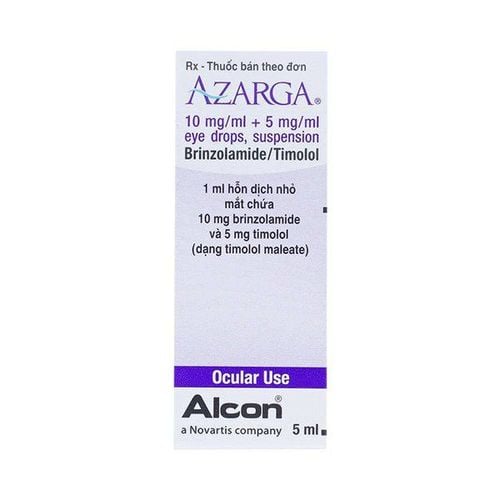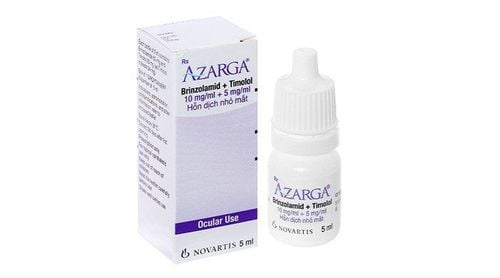This is an automatically translated article.
Azarga drug is prepared in the form of a sterile suspension, containing the main active ingredients are Brinzolamide and timolol. The drug is used for patients with glaucoma or open-angle glaucoma.
1. What does Azarga do?
Azarga eye drops are available as a sterile, homogeneous, white or off-white suspension. The drug contains the active ingredients Brinzolamide and timolol. Although these two active ingredients have different mechanisms, when combined, they will help reduce glaucoma. Azarga is used to lower intraocular pressure in patients with glaucoma or open-angle glaucoma.2. Instructions for using the drug Azarga 2.1. How to use Azarga Azarga is only used for eye drops. When using, the patient should shake the vial well before instilling eye drops.
Some notes when using Azarga:
To avoid contamination of the tip of the dropper and suspension, do not let the dropper tip touch the eyelids, the area around the eyes or any other surface. The patient should keep the vial cap tightly closed when not in use;
After opening the cap, if the ring of the vial comes off, it should be removed before taking the medicine;
After instillation, patients should close their eyes or gently press on the tear ducts to reduce systemic absorption of the drug. This reduces systemic side effects and enhances the local effect of the drug;
If more than one eye drop is used, the patient should use the medications at least 5 minutes apart.
2.2. Dosage of Azarga Drug Dosage is as follows: Put 1 drop of Azarga eye drops into the affected eye x 2 times/day.
For children: The use of Azarga is not recommended for children under 18 years of age because there are currently no research data on the effectiveness and safety of the drug.
Patients with hepatic or renal impairment: There have been no studies on the use of Azarga in patients with hepatic or renal impairment. No dose adjustment is required in patients with mild to moderate hepatic or renal impairment.
Overdose: In case of accidental ingestion of Azarga, patients may experience symptoms such as hypotension, bradycardia, heart failure, bronchospasm, electrolyte imbalance, acidosis, other side effects. side effects on the nervous system,... Need to monitor serum electrolytes and blood pH. Treatment is supportive treatment such as rinsing eyes with warm water, treating symptoms.
Missed dose: If you forget to drop a dose once, the patient should continue to take the next dose exactly as directed. Do not instill more than 1 drop / time, more than 2 times / day into the eye to be treated.

Azarga thuốc nhỏ mắt có dạng bào chế là hỗn dịch vô khuẩn
3. Side effects of the drug Azarga
When using Azarga eye drops, patients may experience some side effects such as:
Common: Neurological (visual disturbances); heart (decreased heart rate); eyes (punctate keratitis, pain, blurred vision, irritation). Uncommon: Blood and lymphatic system (decreased white blood cell count); skin and subcutaneous tissue (flat lichen planus, hair disease); kidney and urinary tract (hematuria); vascular disorders (low blood pressure); respiratory (chronic obstructive pulmonary disease, cough); whole body discomfort,... When experiencing the above side effects, the patient should stop taking Azarga and immediately notify the doctor or go to the nearest hospital for timely treatment.
4. Notes when using the drug Azarga
Contraindicated to use Azarga eye drops in the following cases:
Hypersensitivity to excipients, active ingredients of the drug or sulphonamides; Have a reactive airway disease (bronchial asthma or a history of severe chronic airway obstruction); Sinus bradycardia, sinoatrial block, sinus node syndrome, 2nd or 3rd degree atrioventricular block, heart failure, cardiogenic shock; Severe allergic rhinitis, bronchial hyperresponsiveness, hypersensitivity to other beta-blockers; Hyperchloremic acidosis; Patients with severe renal failure. Precautions when using Azarga:
The active ingredients in Azarga are Brinzolamide (a carbonic anhydrase inhibitor) and timolol (beta blocker) which are absorbed systemically. These ingredients can cause unwanted side effects on cardiovascular, pulmonary, hypersensitivity reactions,...; Disturbances of acid-base balance may occur when taking carbonic anhydrase inhibitors. Use with caution in patients at risk of renal failure (because of the risk of metabolic acidosis); Carbonic anhydrase inhibitors can affect the hydration of the cornea, causing decompensation, corneal edema. Therefore, careful observation should be made when using the drug in patients with corneal damage (keratosis, diabetics); Cardiac Disorders: In patients with cardiovascular disease (heart failure, coronary artery disease, Prinzmetal's angina) and hypotension, drug therapy should be carefully evaluated, monitoring for signs of worsening of the above diseases and side effects; Vascular disorders: Azarga should be used with caution in patients with severe peripheral circulatory disorders (Raynaud's syndrome); Respiratory disorders: Caution is advised when administering Azarga to patients with asthma because of the increased risk of respiratory reactions; Diabetic Hypoglycemia: Azarga should be used with caution in patients with spontaneous hypoglycemia or with unstable diabetes because the drug may mask the signs of acute hypoglycemia; Hyperthyroidism : Medicines can mask the symptoms of hyperthyroidism; Muscle weakness: The drug may cause weakness in the body manifested in symptoms of myasthenia gravis (drooping eyelids, double vision, general weakness); Other beta-blockers: Systemic beta-blocking effects or effects on intraocular pressure may occur when timolol is administered to patients receiving systemic beta-blockers. Therefore, it is necessary to closely monitor the drug response of this group of patients; Hypersensitivity reactions: When taking Azarga, patients with a history of allergies or severe hypersensitivity to certain allergens may react more strongly, not responding to the usual dose of adrenaline to treat hypersensitivity reactions; Choroidal tear: Drug use after trabeculectomy can cause choroidal detachment; Surgical Anesthesia: The drug may inhibit systemic beta-agonist effects such as that of adrenaline. The anesthesiologist should be informed if the patient is taking a medication containing Timolol; Effects on eyes: Use caution when using Azarga for patients, closely monitor intraocular pressure; Contact lenses: This medicine can cause irritation and discolor soft contact lenses. Patients should remove contact lenses before instilling Azarga, wait at least 15 minutes before reinserting; Driving or operating machines: Temporary blurred vision or some other visual disturbances after taking this medicine may affect the ability to drive, use machines. If vision is blurred after eye drops, patients should wait until their vision clears before they can drive or operate machinery; Pregnancy and breast-feeding: It is not recommended to use Azarga during pregnancy and lactation. You should consult your doctor before taking the medicine.

Không khuyến cáo sử dụng thuốc Azarga cho trẻ dưới 18 tuổi
5. Azarga drug interactions
Some drug interactions of Azarga :
Azarga eye drops contain Brinzolamide (a carbonic anhydrase inhibitor) so it is only used in the eyes but the drug is still absorbed by the body. There is a risk of drug interactions with patients receiving oral carbonic anhydrase; When beta-blockers are being used, the hypertensive response to abrupt discontinuation of clonidine may be exacerbated; The risk of systemic beta-blockers including decreased heart rate and depression has been reported when Timolol is used in combination with CYP2D6 inhibitors (paroxetin, fluoxetin, quinidine); Beta-blockers may enhance the hypoglycemic effect of antidiabetic drugs; There is a synergistic effect of bradycardia/hypotension when beta-blocking eye drops are co-administered with beta-adrenergic blocking agents, calcium channel blockers, antiarrhythmics, and oral pseudosympathomimetic agents. or digitalis-type cardiac glycosides; Mydriasis may be possible with concomitant use of adrenaline and beta-blocking eye drops; Azarga may decrease the response to adrenaline used in the treatment of hypersensitivity reactions. Therefore, it should be used with caution in patients with a history of allergy or anaphylaxis. When using Azarga, to ensure effective treatment, reduce the risk of drug interactions or experience unwanted side effects, patients need to adhere to the correct dose and time of taking the drug.
Please dial HOTLINE for more information or register for an appointment HERE. Download MyVinmec app to make appointments faster and to manage your bookings easily.













